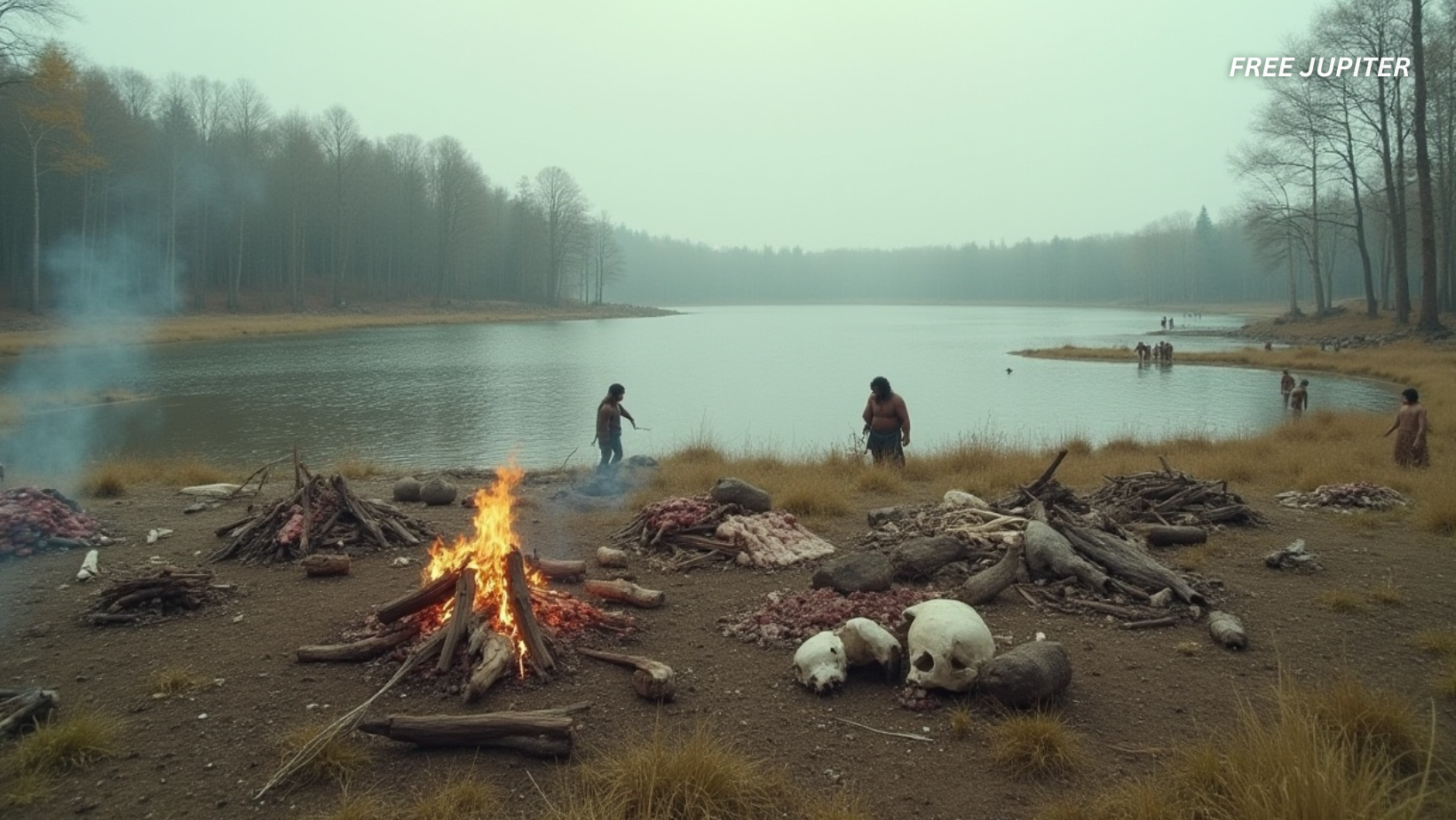Friendly Note: FreeJupiter.com shares general info for curious minds 🌟 Please fact-check all claims—and always check health matters with a professional 💙
When archaeologists set out to dig into a quiet hill near Leipzig, Germany, they probably didn’t expect to uncover what might be the oldest known evidence of an organized food-processing site in human history. But that’s exactly what happened.
Buried beneath layers of soil and time, researchers uncovered a prehistoric “fat factory”—a place where Neanderthals, our long-lost human relatives, systematically broke down animal bones to extract fat. And we’re not talking about the occasional marrow snack. This was a full-blown operation involving hundreds of animals, intentional planning, and a surprisingly sophisticated understanding of nutrition.
It’s the kind of discovery that forces us to take another look at the so-called “cavemen” and ask: Were Neanderthals more advanced than we ever imagined?
An Unexpected Find Beneath the Hill
The discovery happened at Neumark-Nord, a well-known archaeological site near Leipzig, which has been studied for decades. Researchers from Leiden University and other institutions returned to the site with modern tools and fresh eyes, and what they uncovered was striking.
Instead of just scattered bones and flint tools, they found a structured bone-processing area. Thousands of broken bone fragments were scattered across the landscape—some cracked open, others boiled, some even ground down into powder. The site’s layout and the positioning of the remains weren’t random. Everything pointed to a highly organized activity center, specifically for rendering fat from bones.
This wasn’t just survival. It was strategy.
Read more: The Incredible Case Of The Only Known Individual With Parents From Two Different Species
Why Bone Fat?
If you’ve ever gone camping or watched a survival show, you’ve probably heard that bone marrow is packed with calories. But what Neanderthals were doing went far beyond cracking open a few bones for a quick bite.
They were heating bones in water, boiling them to release every last drop of greasy, calorie-rich fat. Today, we’d call this “bone broth.” Back then, it was life-sustaining gold.
During colder periods, plant foods were scarce, and hunting wasn’t always a daily success. Fat became a vital energy reserve, essential for surviving harsh conditions. It also stores well, meaning Neanderthals could plan for leaner times.
Interestingly, the way they processed the bones is similar to techniques used by later groups of Homo sapiens. Native American tribes and Arctic communities, for example, also boiled bones to render grease. This suggests that the knowledge of bone fat’s value may have deeper roots in human evolution than we thought.
More Than Just Scavengers
The findings at Neumark-Nord help push back against one of the oldest myths about Neanderthals: that they were little more than brute scavengers. For years, they’ve been portrayed as less intelligent than modern humans, trudging through the Ice Age without much thought or foresight.
But evidence keeps mounting that Neanderthals were resourceful, organized, and deeply attuned to their environments.
They selected the lakeside area on purpose. It wasn’t just convenient for water—it offered a strategic location to store, process, and possibly even cache parts of the animals they hunted. Some researchers believe Neanderthals may have left carcass parts in specific places to come back to later, a form of food storage.
Imagine that—prehistoric meal prep, 125,000 years before the first fridge.
Related Discoveries That Support the Theory
This isn’t the only evidence of Neanderthal intelligence and resourcefulness. Across Europe and Asia, archaeologists have uncovered a growing list of clues that challenge outdated stereotypes:
- Fire Control: At Neumark-Nord and other sites, there is evidence that Neanderthals not only used fire for warmth and cooking but also for land management. Controlled burning helped them clear forests and attract grazing animals.
- Symbolic Thinking: In Spain, cave art thought to be over 60,000 years old was attributed to Neanderthals. It includes abstract patterns and possibly even intentional markings, hinting at a capacity for symbolism and perhaps early forms of expression.
- Tool Making: Neanderthals created sophisticated tools from stone, bone, and even birch tar (used as glue). Some tools were used for sewing hides, cutting meat, or working wood—far beyond what we once thought they could manage.
- Burials: There are sites that suggest Neanderthals may have intentionally buried their dead, which implies social bonding, memory, or even ritualistic thinking.
Put together, it’s clear that Neanderthals weren’t just surviving. They were innovating.
Read more: Bedbugs Are The Very First Human Pest, And They Have Been Bugging Us For 60,000 Years
Fat Factories and Food Systems
Back to the “fat factory”: the idea that Neanderthals were systematically collecting and processing animal fat hints at a form of early food economy. This wasn’t random scavenging. It was resource management.
According to the researchers, this activity was “intensive, organized, and strategic.” That means:
- They hunted large herbivores like horses and aurochs—massive animals that could provide a lot of meat and fat.
- They transported select parts of these animals to the processing site, focusing on bones with the highest fat yield.
- They boiled, cracked, and stored the fat, probably for later use or to support larger group needs.
This could mean Neanderthals had an understanding of seasonal planning and even division of labor—both hallmarks of advanced social behavior.
A Landscape Frozen in Time
What made all of this possible to discover was the exceptional preservation of the site. Usually, time erodes or scatters clues. But at Neumark-Nord, researchers found not just isolated artifacts, but an entire landscape that had been remarkably well preserved.
The site dates back to an interglacial period, a relatively warm time between Ice Ages, when the environment would have been somewhat similar to modern Europe—forests, lakes, and plenty of animals. This allowed Neanderthals to thrive, not just survive.
As Fulco Scherjon, one of the study’s co-authors, put it, “This is extremely rare for such an ancient site—and opens exciting perspectives for future research.”
Rewriting the Story of Human Evolution
The more we dig, quite literally, into our ancient past, the more we realize that intelligence and complexity didn’t begin with modern humans. Neanderthals, once written off as a side branch of evolution, were far more capable than we’ve given them credit for.
They planned. They hunted in groups. They used fire. They processed food. And they understood that fat = survival.
So, while Henry Ford may have popularized the assembly line, it seems that Neanderthals beat him to the punch—by about 125,000 years.
Read more: The Fascinating Reason Why Human Faces Don’t Look Like Neanderthals’
Final Thoughts: Are We the Only “Smart” Species?
This discovery adds to a growing idea in science: maybe intelligence isn’t as rare as we once thought. Neanderthals may not have had smartphones or writing systems, but they clearly understood complex problems and developed efficient solutions.
So, next time you sip on bone broth or organize a meal prep, think of your ancient cousins grinding mammal bones by a lakeside fire, boiling water in carved-out pits, and making the most of every calorie.
Turns out, they weren’t so different from us after all—just hairier, hungrier, and working with fewer kitchen tools.










